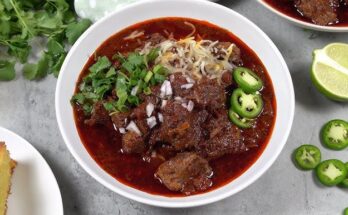Venison Roast Recipe: Cooking a venison roast is not just about throwing meat into the oven—it’s about celebrating wild game and enjoying rich, earthy flavors that bring nature right to your plate. Venison, the meat of deer, has been a staple in the diets of hunters and outdoor enthusiasts for centuries. It’s lean, full of flavor, and incredibly satisfying when cooked right.
What is Venison?
Venison generally refers to meat from deer, but it can also sometimes include elk, antelope, and moose depending on the region. However, in most recipes and butcher shops, it specifically means deer meat. It’s known for its rich, gamey flavor and lean texture. Unlike beef, venison is much lower in fat and has a finer grain, making it an excellent alternative for those looking to eat healthier red meat without sacrificing taste.
Why Choose Venison Over Other Meats?
There are plenty of reasons to choose venison over more common meats like beef or pork:
- Low Fat Content: Venison is much leaner, which makes it ideal for health-conscious eaters.
- Sustainability: Deer are often hunted in the wild or farm-raised with fewer hormones and antibiotics.
- Unique Flavor: It has a distinctive taste that pairs beautifully with herbs, wine, and hearty vegetables.
- Ethical Sourcing: Many people prefer wild-hunted meat for ethical and environmental reasons.
Whether you’re a seasoned hunter or just trying venison for the first time, roasting is one of the best ways to bring out its natural flavors.
Choosing the Right Cut for Venison Roast
Not all cuts of venison are created equal, especially when it comes to roasting. You want a cut that will stay moist and tender through long, slow cooking.
Best Cuts for Roasting
Here are the top cuts recommended for a venison roast:
- Shoulder Roast: A bit tougher but packed with flavor. Perfect for slow roasting or braising.
- Rump Roast: This cut is lean and has a fine grain. It roasts beautifully and slices well.
- Sirloin Tip Roast: Slightly more tender and very lean. Ideal for oven roasting.
- Neck Roast: Often overlooked but excellent when slow-cooked.
Each of these cuts has its own unique texture and flavor, but all of them respond well to a good marinade and slow cooking method.
Where to Buy Quality Venison
If you’re not a hunter or don’t know one, don’t worry—quality venison is just a few clicks away:
- Local Butchers: Many specialty butchers carry venison or can order it for you.
- Online Retailers: Websites like D’Artagnan, Maui Nui Venison, and Broken Arrow Ranch offer fresh, frozen venison delivered to your door.
- Farmer’s Markets: Occasionally, you’ll find vendors who sell game meat locally.
When buying, always check for terms like “grass-fed,” “pasture-raised,” or “wild-caught” to ensure quality.
Ingredients and Kitchen Tools Needed
Before you dive into the cooking, let’s get everything prepped. Good organization is key to a successful roast.
List of Ingredients
Here’s what you’ll need for a simple, flavorful venison roast:
- 2–3 lb venison roast (shoulder or rump)
- 2 tbsp olive oil
- 4 cloves garlic, minced
- 1 large onion, sliced
- 2 cups beef or venison stock
- 1 cup red wine (optional but recommended)
- 2 sprigs rosemary
- 2 sprigs thyme
- 1 tsp salt
- 1/2 tsp black pepper
- 2 carrots, chopped
- 2 celery stalks, chopped
- 2 bay leaves
Optional marinade ingredients:
- 1/4 cup balsamic vinegar
- 1/4 cup soy sauce
- 2 tbsp Worcestershire sauce
Tools and Equipment Checklist
You won’t need anything fancy, but here’s a checklist to make sure you’re set:
- Large cast iron skillet or Dutch oven
- Roasting pan or oven-safe baking dish
- Meat thermometer
- Sharp knife
- Cutting board
- Mixing bowl (for marinade)
- Tongs or spatula
With your ingredients and tools ready, you’re halfway there. Now let’s get to the good part—cooking!
Preparing the Venison Roast
Proper preparation makes all the difference. Venison needs a little more attention than beef, but the results are totally worth it.
How to Properly Thaw Venison
If your roast is frozen, thaw it the right way to preserve texture:
- Refrigerator Method (Recommended): Place the venison in the fridge 24–48 hours before cooking. This slow thaw helps retain moisture.
- Cold Water Bath: If you’re short on time, place the roast (sealed in a leak-proof bag) in a bowl of cold water, changing the water every 30 minutes. It should thaw in 2–3 hours depending on the size.
Avoid microwaving or hot water—it’ll start to cook the meat and ruin the texture.
Marinating Tips for Tender Meat
Since venison is lean, marinating helps tenderize and flavor it:
- Time: Let it marinate for at least 6–8 hours, or overnight for best results.
- Acidic Base: Use balsamic vinegar, red wine, or lemon juice to help break down tough fibers.
- Flavor Boosters: Garlic, rosemary, thyme, soy sauce, and Worcestershire sauce enhance the gamey flavor.
Place the venison in a zip-top bag or glass container with the marinade and refrigerate. Flip it occasionally to ensure even coverage.
Step-by-Step Cooking Instructions
Now we’re ready to bring it all together. This is where your kitchen smells amazing, and your taste buds start dancing.
Searing for Flavor
Searing locks in flavor and gives a beautiful crust:
- Preheat your skillet or Dutch oven on high.
- Add olive oil and heat until shimmering.
- Remove venison from marinade, pat dry, and season with salt and pepper.
- Sear the roast on all sides (2–3 minutes per side) until browned.
This step builds flavor that carries through the whole roast.
Slow Roasting Technique
Here’s where the magic happens:
- Preheat oven to 300°F (150°C).
- Add carrots, celery, onions, and herbs to the roasting pan.
- Place the seared venison on top.
- Pour in stock and wine.
- Cover with a lid or foil and roast for 2.5 to 3 hours.
Check occasionally to make sure there’s enough liquid in the pan—add more broth if needed.
Checking for Doneness
Venison should be cooked to 130–135°F (medium-rare) for tenderness:
- Insert a meat thermometer into the thickest part of the roast.
- If it’s below 130°F, give it another 15–20 minutes.
- Once done, rest the roast for 10–15 minutes before slicing.
This helps the juices redistribute and keeps it moist.
Serving Suggestions and Pairings
You’ve roasted the perfect venison—now what? Serving it right can elevate your meal from good to unforgettable.
Perfect Side Dishes for Venison Roast
Since venison has a bold, earthy flavor, it pairs well with sides that balance or enhance that richness. Here are some classics and creative pairings:
- Mashed Potatoes: Creamy and buttery, they offer a neutral, comforting base.
- Roasted Root Vegetables: Carrots, parsnips, and beets bring out the natural sweetness in the meat.
- Brussels Sprouts or Green Beans: Lightly sautéed or roasted for a slightly bitter contrast.
- Polenta or Wild Rice: Both have rustic textures that complement the gamey roast.
Pro tip: Use the juices from your roast to make a quick pan sauce or gravy. Just simmer the leftover liquid with a bit of cornstarch or flour until thickened—pour it over the sliced roast for an extra hit of flavor.
Wine and Beverage Pairings
Choosing the right drink can truly round out the experience:
- Red Wine: A robust red like Cabernet Sauvignon, Shiraz, or a bold Pinot Noir complements venison’s deep flavor.
- Dark Beer: Try a porter or stout if you prefer beer—its malty notes pair well with roasted meats.
- Non-Alcoholic: Pomegranate juice, black cherry soda, or a spiced herbal tea work surprisingly well with game meats.
The key is balance—don’t overpower the venison with too-sweet or too-bitter beverages.
Storing and Reheating Leftovers
Let’s face it, leftovers are half the joy of cooking. But with venison, you’ll want to handle them right to preserve that beautiful texture and taste.
How to Store Leftover Venison Roast
Once the meal’s over and you’ve resisted eating every last bite, store your leftovers carefully:
- Refrigeration: Place sliced or whole roast in an airtight container with some of the pan juices to keep it moist. Store for up to 3–4 days.
- Freezing: Wrap tightly in plastic wrap or foil, then place in a freezer-safe bag. Label and store for up to 3 months.
Always cool the meat to room temperature before refrigerating or freezing to avoid excess condensation.
Best Reheating Methods
Dry, chewy venison is a crime—and totally avoidable.
- Oven Method: Preheat to 275°F, place venison in a baking dish with a splash of broth, cover with foil, and heat for 15–20 minutes.
- Stovetop: Slice thinly and warm gently in a skillet with a touch of oil or broth.
- Microwave (Last Resort): Use low power and short intervals, covering with a damp paper towel to prevent drying out.
Whatever method you choose, reheat slowly and evenly.
Common Mistakes to Avoid When Cooking Venison
Even the best recipes can go sideways if a few common pitfalls aren’t avoided.
Overcooking the Meat
This is the number one mistake people make. Venison is lean—overcook it, and it becomes tough and dry. Always use a meat thermometer and aim for medium-rare (130–135°F). It will continue to cook slightly while resting.
Skipping the Marinate or Seasoning
Venison needs a flavor boost. Skipping the marinade or seasoning means missing out on tenderness and taste. Use acidic components (like vinegar or wine) and herbs that complement the gamey notes.
Cooking Cold Meat
Always bring the roast to room temperature before cooking. Cold meat doesn’t cook evenly, leading to a burnt exterior and raw center.
Not Letting It Rest
Once cooked, always rest the roast for 10–15 minutes. This lets the juices redistribute, preventing them from spilling out the moment you slice in.
Mastering these basics ensures your roast is perfect every time.
Health Benefits of Eating Venison
Venison isn’t just delicious—it’s a powerhouse of nutrition. If you’re looking for a healthier alternative to traditional red meats, this is it.
Low in Fat, High in Protein
Venison contains significantly less fat than beef or pork. A 3-ounce serving has around 3 grams of fat and over 25 grams of protein, making it an excellent choice for athletes, dieters, or anyone watching their macros.
Rich in Essential Nutrients
You’ll also find plenty of:
- Iron: Helps maintain healthy blood and energy levels.
- Zinc: Supports immune function.
- B Vitamins: Essential for energy metabolism.
Wild and Natural
Many venison sources are wild or pasture-raised without added hormones or antibiotics. That means fewer synthetic substances and a more sustainable protein option overall.
So the next time you’re choosing meat, think of venison as a nutrient-rich alternative with a flavor profile that adds variety to your meals.
Variations and International Twists
Venison roast isn’t limited to traditional recipes. You can give it a creative spin based on cuisines from around the world.
French-Inspired Venison Roast
Use a red wine reduction, pearl onions, and mushrooms (think Boeuf Bourguignon but with venison). Add bacon or pancetta for depth.
German Style with Sauerkraut
Incorporate juniper berries, mustard seeds, and cook it low and slow with sauerkraut for a tangy, rich twist.
Caribbean Jerk-Style
Marinate your venison in a jerk spice blend—thyme, allspice, cinnamon, scotch bonnet—and roast it for bold, spicy results.
Asian Fusion
Try soy sauce, ginger, garlic, and hoisin in the marinade, and serve with bok choy or jasmine rice for an East-meets-West combo.
By exploring different flavors, you can enjoy venison in totally new ways.
Making Gravy from Roast Drippings
One of the best things about a venison roast? The delicious, savory drippings left behind in the pan. Don’t let them go to waste—turn them into a rich, velvety gravy that ties the whole meal together.
Simple Gravy Recipe
Here’s a foolproof method to make flavorful venison gravy:
Ingredients:
- Pan drippings (from your roast)
- 2 tbsp butter
- 2 tbsp flour
- 1 cup beef or venison broth (add more as needed)
- Salt and pepper to taste
Instructions:
- After removing the roast, place the pan over medium heat on the stovetop.
- Add butter to the drippings and whisk until melted.
- Sprinkle in flour to form a roux. Whisk constantly for 2–3 minutes until golden.
- Slowly pour in broth, whisking to avoid lumps.
- Bring to a simmer and cook until thickened.
- Taste and season with salt and pepper.
This gravy adds moisture and richness to every bite, and it’s a wonderful way to use every part of your roast.
Tips for First-Time Venison Cooks
If this is your first time cooking venison, it’s natural to feel a bit intimidated. But don’t worry—we’ve all been there. These beginner-friendly tips will help you feel confident and nail it on your first try.
Start with a Simple Recipe
Avoid overcomplicated techniques your first time. Stick with a classic roast—sear, season, roast slowly—and build your confidence from there.
Taste as You Go
When possible (like in gravies or marinades), taste often and adjust the seasoning. Venison can be bold, so finding the right balance matters.
Use a Thermometer
Seriously—don’t guess. Venison goes from perfect to overcooked fast. A simple digital thermometer takes all the guesswork out of it.
Let It Rest
It might seem minor, but it’s essential. Cutting too early causes juices to spill out, leaving your roast dry. Wait 10–15 minutes before slicing.
Don’t Fear the Gamey Flavor
Many first-timers expect venison to taste exactly like beef. It doesn’t—and that’s a good thing! Embrace the slightly wild, earthy flavor. It’s what makes venison unique and exciting.
Sourcing Ethical and Sustainable Venison
As more people become conscious of where their food comes from, ethical sourcing is a big concern. The good news? Venison is one of the most sustainable meat choices you can make.
Wild-Harvested Venison
Much of the venison in North America comes from hunting, which can be highly sustainable when done legally and ethically. Controlled hunting helps manage deer populations and ecosystems.
Farm-Raised Venison
Farm-raised deer live in low-stress environments with access to pasture, clean water, and a natural diet. These farms often avoid antibiotics and hormones, making the meat cleaner and healthier.
How to Ensure Ethical Sourcing:
- Buy from local farms or butchers who know their suppliers.
- Look for certifications (like “Certified Humane” or “Free Range”).
- Ask questions about where and how the deer were raised or harvested.
Ethically sourced venison supports small businesses, conservation, and your health—win-win-win.
Venison Roast Recipe Card (Quick Recap)
Here’s a quick reference guide you can print or save for future use.
| Ingredient | Amount |
|---|---|
| Venison roast | 2–3 lbs |
| Olive oil | 2 tbsp |
| Garlic (minced) | 4 cloves |
| Onion (sliced) | 1 large |
| Beef/venison broth | 2 cups |
| Red wine (optional) | 1 cup |
| Carrots (chopped) | 2 |
| Celery (chopped) | 2 stalks |
| Rosemary | 2 sprigs |
| Thyme | 2 sprigs |
| Bay leaves | 2 |
| Salt | 1 tsp |
| Black pepper | 1/2 tsp |
Cooking Steps:
- Thaw and marinate meat.
- Sear roast on all sides.
- Add veggies, broth, and wine to roasting pan.
- Roast at 300°F for 2.5–3 hours.
- Check temp (aim for 130–135°F).
- Rest 10–15 mins before slicing.
- Serve with gravy and sides.
FAQs about Venison Roast Recipe
1. What is the best cut of venison for a roast?
The most popular cuts for a venison roast are the shoulder, hindquarter, or sirloin roast. These cuts are flavorful and become tender with slow roasting.
2. How do I make venison roast less gamey?
To reduce the gamey flavor, marinate the venison in buttermilk, vinegar, or wine for several hours or overnight. Herbs like rosemary, thyme, and garlic also help balance the taste.
3. How long should I cook venison roast?
Cooking time depends on the weight and method. For oven roasting, cook at 325°F (165°C) for about 20-25 minutes per pound, or until the internal temperature reaches 130-135°F (54-57°C) for medium-rare.
4. Should I sear venison before roasting?
Yes. Searing the venison in a hot skillet before roasting locks in juices and adds a rich, savory crust to the meat.
5. What should I serve with venison roast?
Great side dishes include roasted vegetables, mashed potatoes, wild rice, or a rich gravy made from the pan drippings.
6. Can I cook venison roast in a slow cooker?
Absolutely! A slow cooker helps tenderize tougher cuts. Cook on low for 6–8 hours with broth, herbs, and vegetables for a hearty meal.
7. How do I store leftover venison roast?
Wrap leftovers tightly and refrigerate for up to 3 days. For longer storage, freeze in airtight containers for up to 3 months.
Conclusion
Cooking a venison roast might seem like a culinary adventure, and guess what—it is! But it’s the kind of adventure that’s totally worth it. With the right cut, a solid marinade, a low-and-slow roasting method, and the right sidekicks like roasted vegetables and homemade gravy, your dinner table will be transformed into something truly special. Whether you’re a seasoned hunter or just someone who scored some venison from a friend or local butcher, roasting it is one of the best ways to enjoy all that this wild, flavorful meat has to offer.
Give yourself the chance to slow down, cook with care, and enjoy the rich rewards of a perfectly done venison roast. Your taste buds (and dinner guests) will thank you.



